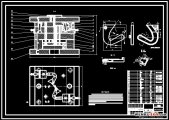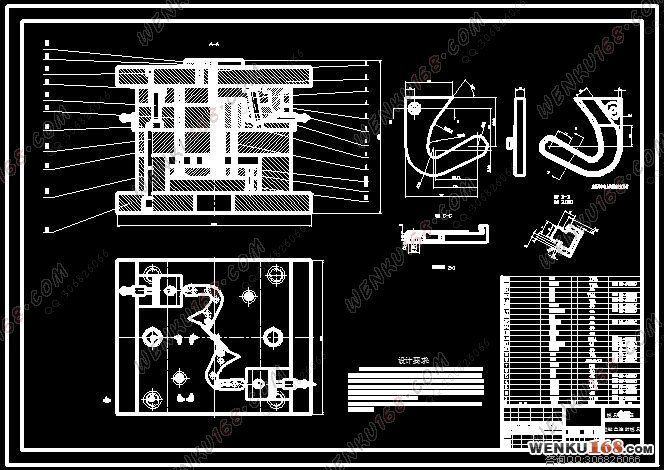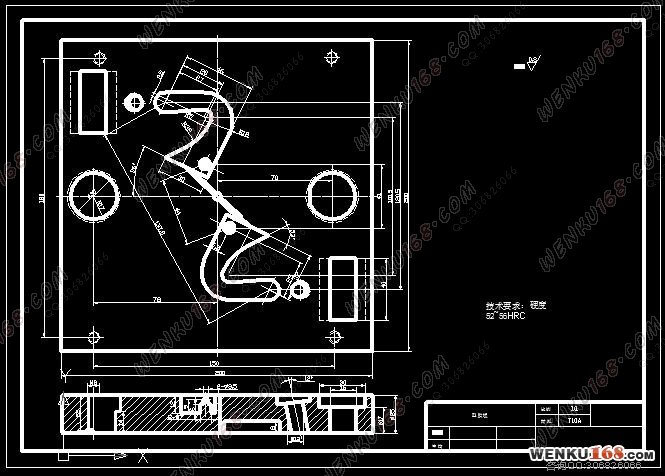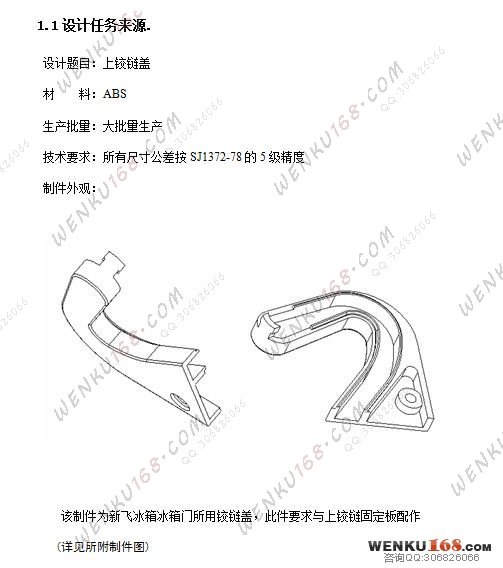铰链盖的模具设计
来源:wenku168.com 资料编号:WK1686568 资料等级:★★★★★ %E8%B5%84%E6%96%99%E7%BC%96%E5%8F%B7%EF%BC%9AWK1686568
资料介绍
铰链盖的模具设计(含任务书,开题报告,中期检查表,论文说明书13000字,CAD图纸10张)
摘 要
该模具为冰箱上所使用的铰链盖的注塑模。此制件的壁厚较薄,表面质量要求一般,对模具的精度要求也一般。在设计中,根据塑件自身的特征,采用一模两腔式,分流道采用梯形,并使用一模多腔中常用的平衡式分布,在塑件侧面上用侧浇口进行注射,侧抽芯机构采用斜导柱抽芯,推出方式采用推杆推出机构。模具的设计应当效率高、安全、可靠。
模具的设计应当效率高、安全、可靠。模具零件应耐磨耐用。模具的设计遵循制造方便,造价便宜的原则。
关键词:铰链盖,注塑模,侧浇口,分流道,侧型芯,顶杆
Mold design of the injection in hing’s lid
Abstract
This is a injection mold for hing’s lid which is used in Refrigerator .The surface quality of the plastic part needn’t have high request, so the mold need not have high request to the accuracy of the mold in the design.According to the characteristic of the plastic part, It is adopted the type of two cavities in the mold, which using the balance equilibrium type to distribute in common .The plastic part is injected on a side by the edge gate. The shape of the runner is trapezium. The moving core is actuated by means of the angled dowel pin.And the mold uses the ejectors pin push parts out of the cavities.
The mold design should be efficient, safe and reliable. The parts of the mold should be Wearable and durability. The design follow the principles
of easily manufacture and costing cheaper.
Keyword: hing’s lid, The plastic injection mold, edge gate, runner, moving core, ejectors pin
目 录
摘要………………………………………………………………………………………………1
绪论………………………………………………………………………………………………3
第一章、任务来源及设计目的意义……………………………………………………………6
1.1设任务来源…………………………………………………………………………………6
第二章、工艺分析………………………………………………………………………………7
2.1 塑件工艺性分析……………………………………………………………………………7
2.1.1 塑件原材料分析…………………………………………………………………………6
2.1.2 塑件的表面质量、尺寸精度及结构分析………………………………………………7
2.2 计算塑件的体积和质量……………………………………………………………………8
2.3 塑件注塑工艺参数的确定…………………………………………………………………8
第三章、注塑模结构设计………………………………………………………………………9
3.1 型腔数目的确定……………………………………………………………………………9
3.2 分型面的选择………………………………………………………………………………9
3.3确定型腔的排列方式………………………………………………………………………10
3.4浇注系统的设计……………………………………………………………………………11
3.4.1 主流道及衬套设计………………………………………………………………………11
3.4.2 定位圈的选择……………………………………………………………………………12
3.4.3 分流道设计………………………………………………………………………………13
3.4.4 冷料穴与拉料杆的设计…………………………………………………………………13
3.5 确定调温系统结构………………………………………………………………………16
3.6 确定排气系统的形式……………………………………………………………………16
3.7 确定脱模方式……………………………………………………………………………16
3.8 模架的选择………………………………………………………………………………17
3.9 侧向分型和抽芯设计……………………………………………………………………19
3.9.1抽拔距的计算…………………………………………………………………………19
3.9.2斜导柱驱动的结构组成及设计………………………………………………………19
3.10 成型零件的结构设计…………………………………………………………………21
3.10.1 凹模设计……………………………………………………………………………21
3.10.2 凸模的结构设计……………………………………………………………………21
3.11 结构与辅助零部件设计………………………………………………………………21
第四章、 注塑机的校核……………………………………………………………………22
4.1 注射量的校核………………………………………………………………………… 22
4.2 注射压力的校核…………………………………………………………………………22
4.3 开模行程的校核…………………………………………………………………………23
4.4 模具高度与注射机闭合高度的关系校核………………………………………………23
第五章、 模具温度系统结构设计…………………………………………………………24
5.1 冷却水道直径计算……………………………………………………………………24
第六章、注塑模主要零件加工及工艺规程的编制…………………………………………25
6.1 型芯的加工工艺分析……………………………………………………………………25
6.1.1 工艺性分析……………………………………………………………………………25
6.1.2 工艺方案………………………………………………………………………………26
6.2 模具零件的机械加工工序卡……………………………………………………………26
第七章、模具的装配与调试…………………………………………………………………28
7.1 模具的装配………………………………………………………………………………28
7.2 模具的调试………………………………………………………………………………28
致谢……………………………………………………………………………………………32
参考文献………………………………………………………………………………………33
|







